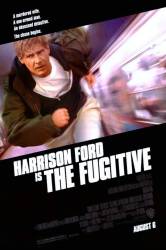Other mistake: When Kimble takes the elevator to the conference to confront Dr. Nichols, he presses a button, but the one beside it is the one that actually lights up. In this particular elevator, the button he pressed is the one that should have lit up.
Other mistake: When Dr. Nichols hits Dr. Kimble with a chair, look carefully. As Dr. Nichols swings the chair, it starts falling apart before it even makes contact with Harrison.
Other mistake: When Harrison Ford is being chased in an ambulance by the police, there is a shot of police cars heading towards the waterfalls in the background. If you look closely, the water is not moving. (00:33:15)
Suggested correction: The water IS moving, you just need to look closely.
Other mistake: After Kimble has been rescued from the train wreck and unchained, he escapes, running alongside a body of water. As Gerard announces to the other officers that there's a fugitive on the loose and gives instructions, Kimble is seen running again, in a replay of the earlier shot. Not only are all the same landmarks in place, but at the end of both sequences, he moves his arm to shake off a branch that's snagged him.
Other mistake: After the train crash the news crews and sheriff are interviewing the surviving corrections officer. He boasts how heroic he was to rescue his partner from the wreckage, claiming that he was his partner and he would do the same for him. The only problem is that they are surprised when they find that same surviving corrections officer several scenes later and rush him to the hospital. Why would they be surprised to find an officer they already knew about?
Suggested correction: The first corrections officer had been exposed as a liar and made up the story that Kimble and Copeland were dead. Nobody believed he heroically saved his partner. Everyone assumed since the partner hadn't been found right away that he died in the wreck. It never occurred to anyone that Kimble would put his own life on the line to save a guard, so actually finding the guard alive was a surprise.
There is nothing formally wrong with the order of events here. The assumption is that the second officer's whereabouts are known at the time of the senior officer's story - but that is actually only an assumption. Finding the second officer would of course not be important to the main story in any way, and thus this sub-story was not explained in the movie. To word it an alternative better way, why would the senior officer make up this story of saving the second officer, if the officer had not been located yet?
The second officer's whereabouts are most certainly not known when the first officer is interviewed. The first officer is interviewed the night of the crash and the second officer is found the next morning.
Other mistake: When Kimble is heading towards the dam driving the ambulance in the tunnel, his lane is empty in the wide angles, yet in the close-ups he is swerving the steering wheel violently as if there were cars ahead. This keeps changing back and forth.
Other mistake: After we see a shot of the prison bus driving along a road, the white, balding jail guard says, "20 miles to Benard. We should be there in 40 minutes." Not long after, one of the inmates begins to foam at the mouth. The black prisoner cries, "Hey, somebody, get in here quick!" The black jail guard stands up to unlock the cage, and the white, balding guy says to him, "We're almost to the prison." This is impossible considering he just mentioned the prison was 20 miles away. (00:14:52)
Suggested correction: Almost is a relative word and compared to Chicago/Cook County, they could almost be at the prison (when flying from NYC to LAX, when you are over Utah, you are almost there even though you still have like an hour to go). But more likely (and how I have always taken it to mean), the guard didn't give two cents if these prisoners died in transport and the other guard should just sit tight because they are almost where they have to go and the prison doctors can look at him then.
Other mistake: During the St. Patrick's Day parade, the camera shows a clock that displays the temperature, which is supposedly 23°. None of the spectators or performers we see is dressed for that temperature. They would be way more bundled up than they are. Everybody is dressed for weather in the 40s or so.
Suggested correction: 20s is nice and toasty.





